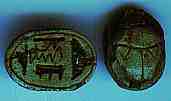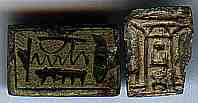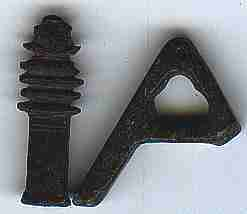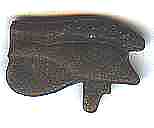 |
The Bead SiteHome>Uses of Beads>Religion & Amulets > Egyptian Amulets
Egyptian Amulets
Egyptian faience amulets
Many people use amulets, but none as much as the ancient Egyptians. Some of these are true amulets, warding off evil, others are really talismans, to bring good luck.
|
The most important amulet in ancient Egypt was the scarab, a dung beetle thought to roll the sun across the sky. They were used as seals and also as gifts to friends. Most were made of soapstone (steatite).
Donor: Keela Rodgers
|

|
|

|
Rectangular tabular plaques were also common. They were often inscribed on both sides. Notice the same message on the scarab and the left plaque. It is common, perhaps a good will wish. The plaque on the right is faience.
Left donated by Keela Rogers
|
|
Two stone amulets. The one on the left is a Djed pillar, a symbol of stability. The one on the right is a mason's A form, with one leg broken. The Djed was a common amulet, but the A was probably only used by masons in life or death.
|

|
|

|
A stone Udjat. This is the Eye of Horus, son of Isis. It also serves to ward off the Evil Eye, a common superstition in the Middle East. The carved outline of the eyes and eyebrows on top are barely visible on the dark stone.
|
|
A variety of stone amulets. They are: upper left an Udjat; lower left a fish; center left a man or monkey; right center a hawk; far right a man. These are as crude as their faience counterparts.
Donor: the late Mrs. F.E. Willsie of Victoria B.C., Canada. Who?
|

|
|
Egyptian Faience Amulets
Faience
__________________________________________________
Small Bead Businesses | Beading & Beadwork | Ancient Beads | Trade Beads
Beadmaking & Materials | Bead Uses | Researching Beads | Beads and People
Center for Bead Research | Book Store | Free Store | Bead Bazaar
Shopping Mall | The Bead Auction | Galleries | People | Events
The Bead Site Home | Chat Line | Contact Us | Site Search Engine | FAQ
|
 |




